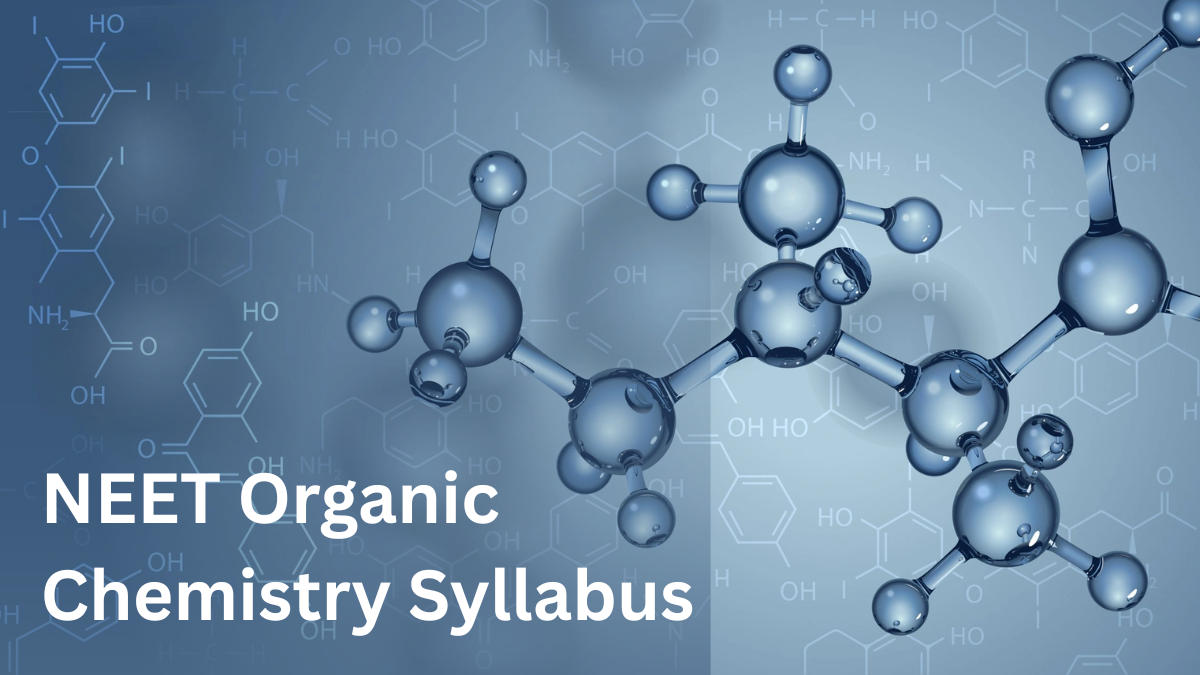Table of Contents
NEET Organic Chemistry Syllabus 2025: Organic Chemistry is one of the most significant and high-weightage areas in NEET UG 2025. The NEET Chemistry syllabus is divided into three sections: Physical, Inorganic and Organic Chemistry. Over the years, as questions are frequently asked from this section, students must strategically prepare the topics included in the NEET Organic Syllabus 2025. To make things simple for the students, we have also shared the List of the most important chapters of Organic chemistry along with a detailed syllabus on this page.
NEET Organic Chemistry Syllabus 2025
In the NEET Chemistry Section, the Organic Chemistry presents several questions. Key topics, including reaction procedures, named reactions, and functional groupings, can boost marks. Organic Chemistry typically accounts for 20-28% of the NEET exam’s overall Chemistry marks. Organic Chemistry makes up around 15-20% of the 45 Chemistry questions on the exam. This proportion remains consistent year after year, making it a crucial component of the Chemistry course.. Knowing the NEET Organic Chemistry Syllabus 2025 and important topics in each chapter might help you prepare more effectively for achieving high NEET exam scores.
NEET Organic Chemistry Syllabus in Detail
As per the Official NEET Chemistry Syllabus for organic, there are a total of 7 units and each chepters consists of various topics and subjects. Let’s check unit wise detailed NEET Organic Chemistry Syllabus 2025 discussed below.
UNIT 13: PURIFICATION AND CHARACTERISATION OF ORGANIC COMPOUNDS
- Purification – Crystallisation, sublimation, distillation, differential extraction, and chromatography – principles and their applications.
- Qualitative analysis – Detection of nitrogen, sulphur, phosphorus, and halogens.
- Quantitative analysis (basic principles only) – Estimation of carbon, hydrogen, nitrogen, halogens, sulphur, phosphorus.
- Calculations of empirical formulae and molecular formulae: Numerical problems in organic
quantitative analysis,
UNIT 14:SOME BASIC PRINCIPLES OF ORGANIC CHEMISTRY
- Tetravalency of carbon: Shapes of simple molecules – hybridization (s and p): Classification of
organic compounds based on functional groups: and those containing halogens, oxygen, nitrogen,
and sulphur; Homologous series: Isomerism – structural and stereoisomerism. - Nomenclature (Trivial and IUPAC)
- Covalent bond fission – Homolytic and heterolytic: free radicals, carbocations, and carbanions;
stability of carbocations and free radicals, electrophiles, and nucleophiles. - Electronic displacement in a covalent bond – Inductive effect, electromeric effect, resonance, and hyperconjugation.
- Common types of organic reactions- Substitution, addition, elimination, and rearrangement.
UNITS 15: HYDROCARBONS
- Classification, isomerism, IUPAC nomenclature, general methods of preparation, properties, and
reactions. - Alkanes – Conformations: Sawhorse and Newman projections (of ethane): Mechanism of
halogenation of alkanes. - Alkenes – Geometrical isomerism: Mechanism of electrophilic addition: addition of hydrogen,
halogens, water, hydrogen halides (Markownikoffs and peroxide effect): Ozonolysis and
polymerization. - Alkynes – Acidic character: Addition of hydrogen, halogens, water, and hydrogen halides:
Polymerization. - Aromatic hydrocarbons – Nomenclature, benzene – structure and aromaticity: Mechanism of
electrophilic substitution: halogenation, nitration. - Friedel – Craft’s alkylation and acylation, directive influence of the functional group in monosubstituted benzene.
UNIT 16: ORGANIC COMPOUNDS CONTAINING HALOGENS
- General methods of preparation, properties, and reactions; Nature of C-X bond; Mechanisms of
substitution reactions. - Uses; Environmental effects of chloroform, iodoform freons, and DDT.
UNIT 17: ORGANIC COMPOUNDS CONTAINING OXYGEN
- General methods of preparation, properties, reactions, and uses.
- Alcohols: Identification of primary, secondary, and tertiary alcohols: mechanism of dehydration.
- Phenols: Acidic nature, electrophilic substitution reactions: halogenation. nitration and
sulphonation. Reimer – Tiemann reaction. - Ethers: Structure.
- Aldehyde and Ketones: Nature of carbonyl group; Nucleophilic addition to >C=O group,
relative reactivities of aldehydes and ketones; Important reactions such as – Nucleophilic addition
reactions (addition of HCN. NH3, and its derivatives), Grignard reagent; oxidation: reduction
(Wolf Kishner and Clemmensen); the acidity of -hydrogen. aldol condensation, Cannizzaro
reaction. Haloform reaction, Chemical tests to distinguish between aldehydes and Ketones. - Carboxylic Acids
- Acidic strength and factors affecting it,
UNIT 18: ORGANIC COMPOUNDS CONTAINING NITROGEN
- General methods of preparation. Properties, reactions, and uses.
- Amines: Nomenclature, classification structure, basic character, and identification of primary, secondary, and tertiary amines and their basic character.
- Diazonium Salts: Importance in synthetic organic chemistry.
UNIT 19: BIOMOLECULES
- General introduction and importance of biomolecules.
- CARBOHYDRATES – Classification; aldoses and ketoses: monosaccharides (glucose and
fructose) and constituent monosaccharides of oligosaccharides (sucrose, lactose, and maltose). - PROTEINS – Elementary Idea of -amino acids, peptide bond, polypeptides. Proteins: primary,
secondary, tertiary, and quaternary structure (qualitative idea only), denaturation of proteins,
enzymes. - VITAMINS – Classification and functions.
- NUCLEIC ACIDS – Chemical constitution of DNA and RNA. Biological functions of nucleic acids.
- Hormones (General introduction)
UNIT 20: PRINCIPLES RELATED TO PRACTICAL CHEMISTRY
Detection of extra elements (Nitrogen, Sulphur, halogens) in organic compounds; Detection of
the following functional groups; hydroxyl (alcoholic and phenolic), carbonyl (aldehyde and
ketones) carboxyl, and amino groups in organic compounds. The chemistry involved in the preparation of the following:
- Inorganic compounds; Mohr’s salt, potash alum.
- Organic compounds: Acetanilide, p-nitro acetanilide, aniline yellow, iodo
- The chemistry involved in the titrimetric exercises – Acids, bases and the use of indicators, oxalicacid vs KMnO4, Mohr’s salt vs KMnO4
- Chemical principles involved in the qualitative salt analysis:
Cations – Pb2+, Cu2+, Al3+, Fe3+, Zn2+, Ni2+, Ca2+, Ba2+, Mg2+, NH+
Anions- CO2−, S2-,SO2−,NO3-, NO2-, Cl-, Br-, I-
( Insoluble salts excluded).
Chemical principles involved in the following experiments:
1. Enthalpy of solution of CuSO4
2. Enthalpy of neutralization of strong acid and strong base.
3. Preparation of lyophilic and lyophobic sols.
4. Kinetic study of the reaction of iodide ions with hydrogen peroxide at room temperature.
NEET Organic Chemistry Syllabus 2025 PDF Download
Students may download the NEET Syllabus for Organic Chemistry in a downloadable PDF by simply clicking the direct link shared below. Students are advised to download and print the NEET UG organic chemistry syllabus, so that they can track their preparation easily.
Best Books for NEET Organic Chemistry
Choosing the right books is crucial for studying for the NEET organic chemistry syllabus as well as developing an effective study approach.Check some of the best reference books for NEET Organic Chemistry.
- NCERT Chemistry textbooks for Class XI and XII
- ABC of Chemistry for Classes 11 and 12 by Modern
- Dinesh Chemistry guide
- Practice book by M S Chauhan



 NEET City Intimation Slip 2025 Release D...
NEET City Intimation Slip 2025 Release D...
 NTA NEET Cut Off 2025, Expected Cutoff f...
NTA NEET Cut Off 2025, Expected Cutoff f...
 NEET UG 2025: Is NEET Previous years Que...
NEET UG 2025: Is NEET Previous years Que...



